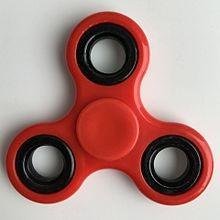A fidget spinner is a toy that consists of a bearing in the center of a multi-lobed flat structure made from metal or plastic designed to spin along its axis with little effort. 
Fidget spinners became popular toys in 2017, although similar devices had already been invented in 1993. The toy became popular among schoolchildren. Some schools banned the spinners for being a distraction, while other schools allowed the toy to be used discreetly.
The toy has been advertised as helping people who have trouble with focusing or fidgeting by relieving nervous energy or psychological stress. As of May 2017, there is no scientific evidence that they are effective as a treatment for autism or ADHD.
Fidget spinners are useless machines designed to spin with little effort.[1][2] A basic fidget spinner consists of a two or three pronged design with a bearing in its center circular pad.[2][3] A person holds the center pad while the toy spins.[3] They are made from various materials including brass, stainless steel, titanium, copper, aluminium, and plastic.[1][2][4] The bearings are generally ceramic, metal (stainless steel or chrome), and some are hybrids—such as ceramic balls with stainless races and cages. Each fidget spinner also has two or more weights on the outside that make it spin faster and stay balanced. Bearings can vary to adjust for the design's spin time, vibration, and noise, causing unique sensory feedback.
As of 2017, the patent status of the various fidget spinners on the market was unclear.[5]
Catherine Hettinger, a chemical engineer by training, was initially credited by some news stories to have been the inventor of the fidget spinner, including by media outlets such as The Guardian,[6] The New York Times,[7] and the New York Post.[8] Hettinger filed a patent application for a "spinning toy" in 1993 and a patent was issued, but Hettinger allowed the patent to lapse in 2005 after she could not find a commercial partner.[6][5] A May 2017 Bloomberg News article showed that Hettinger was not the inventor of the fidget spinner, and Hettinger agreed.[5]
In an interview appearing on May 4, 2017 on NPR, Scott McCoskery described how he invented a metal spinning device in 2014 to cope with his own fidgeting in IT meetings and conference calls.[9] In response to requests from an online community, he began selling the device he called the Torqbar online.[9]
When fidget spinners rose in popularity in 2017, many publications discussed their claimed benefits for individuals with ADHD, autism, or anxiety.[19][21][22][6][23] There is no scientific evidence that fidget spinners are effective as a treatment for children with autism or ADHD.
credit-
Hi! I am a robot. I just upvoted you! I found similar content that readers might be interested in:
https://www.youtube.com/watch?v=3DeLkee3p9wDownvoting a post can decrease pending rewards and make it less visible. Common reasons:
Submit
Not indicating that the content you copy/paste is not your original work could be seen as plagiarism.
Some tips to share content and add value:
Repeated plagiarized posts are considered spam. Spam is discouraged by the community, and may result in action from the cheetah bot.
Creative Commons: If you are posting content under a Creative Commons license, please attribute and link according to the specific license. If you are posting content under CC0 or Public Domain please consider noting that at the end of your post.
If you are actually the original author, please do reply to let us know!
Thank You!
Downvoting a post can decrease pending rewards and make it less visible. Common reasons:
Submit